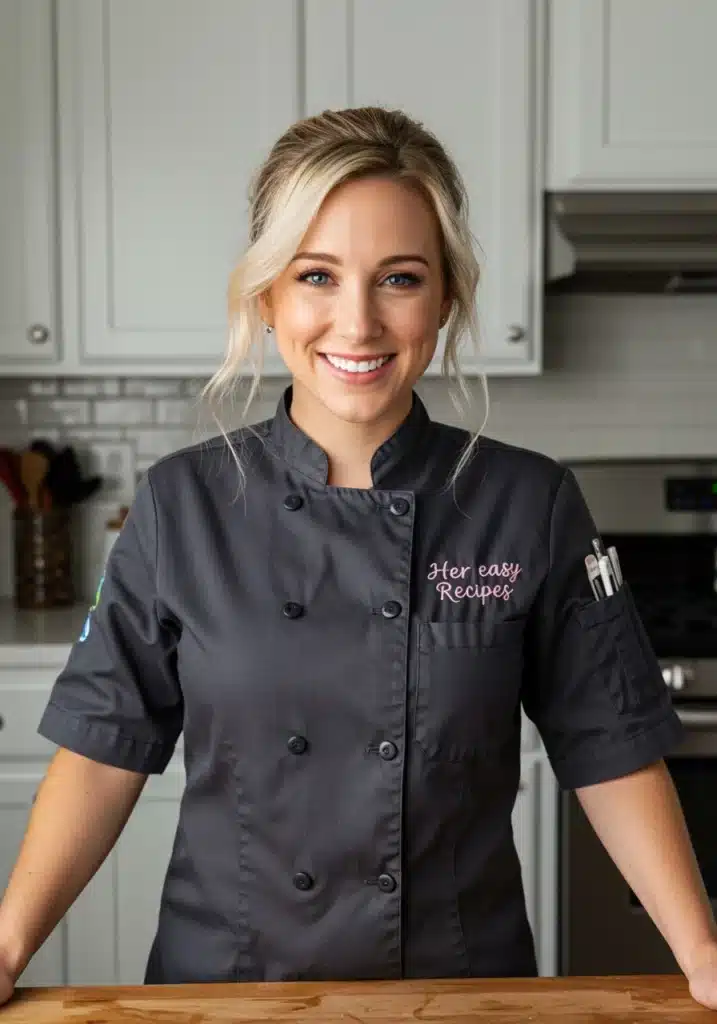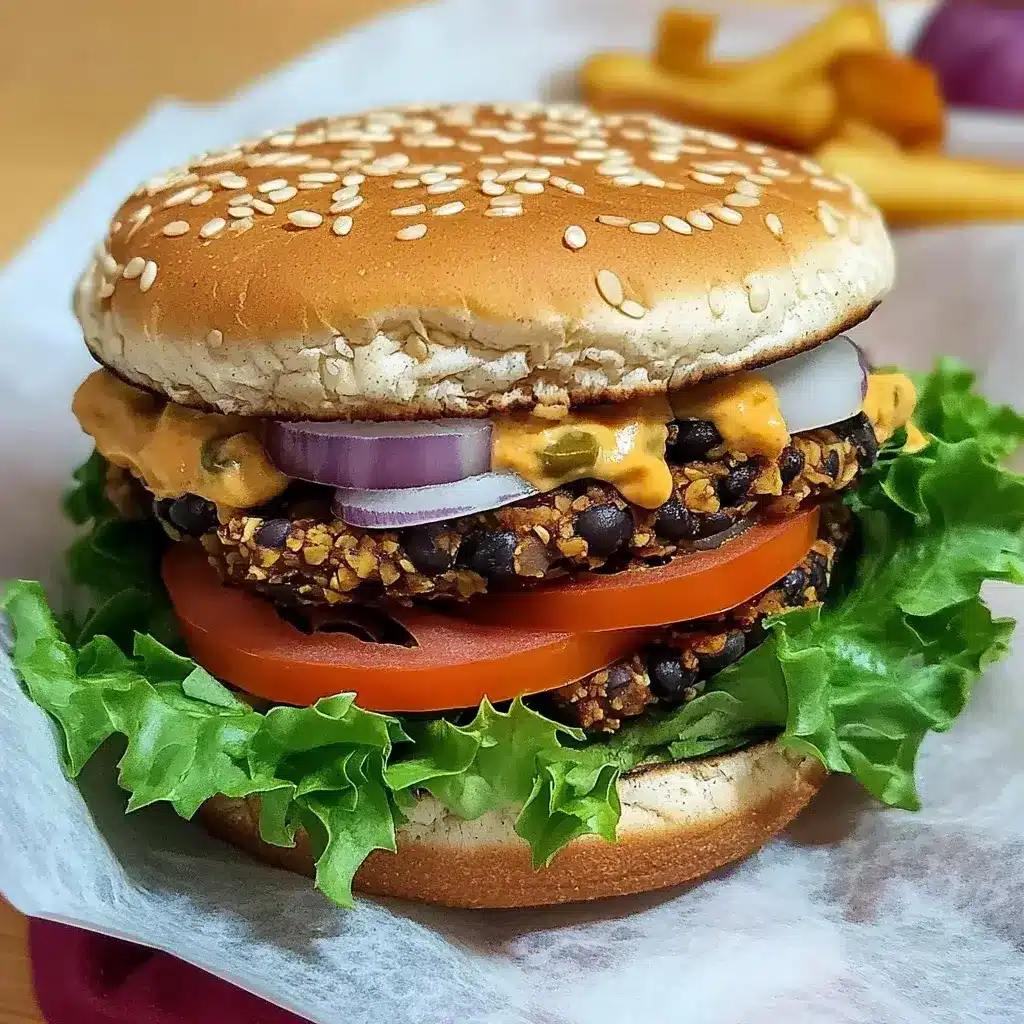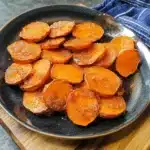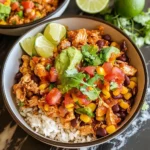My journey to the perfect homemade Vegetarian Black Bean Burger was paved with… well, a lot of crumbly disappointments. For years, I was searching for that elusive combination: a veggie burger bursting with flavour, satisfyingly hearty, and most importantly, one that actually held its shape on the bun instead of disintegrating at first bite. Store-bought options often felt lacking, either too dry, too mushy, or just bland. My early attempts at homemade versions often resulted in patties that were delicious in theory but structurally unsound. Then, through much trial and error (and maybe a few frustrating collapses onto the skillet), I finally landed on this recipe. It involves a few key techniques – properly managing moisture, using the right combination of binders, and building layers of flavour – that make all the difference. The first time I served these black bean burgers, watching my family bite into juicy, flavour-packed patties that stayed perfectly intact, I knew I’d cracked the code. They are now a staple in our house, requested even by the dedicated meat-eaters, proving that a vegetarian burger can be incredibly satisfying and crave-worthy in its own right.
Ingredients
Creating a truly great Vegetarian Black Bean Burger hinges on selecting ingredients that contribute not only flavour but also the right texture and binding properties. The foundation is, naturally, black beans, providing earthy flavour, protein, and substance. To hold everything together (the crucial binding step), we rely on a combination of ingredients like breadcrumbs (Panko preferred for crunch), eggs (or a vegan alternative like a flax egg), and the natural starchiness of the beans themselves. Aromatic vegetables like onion, garlic, and bell pepper form the flavour base, adding moisture (which needs careful management) and depth. Spices are key for that characteristic burger “kick” – cumin, chili powder, smoked paprika, and oregano are classic choices. A touch of fat (from oil used for sautéing) helps with cooking and mouthfeel, while optional additions like corn, nuts, or seeds can add textural interest and extra nutrients.
- 1 tablespoon Olive Oil or Vegetable Oil
- 1 small Yellow Onion, finely chopped (about 3/4 cup)
- 1/2 medium Red Bell Pepper, finely chopped (about 1/2 cup)
- 3 cloves Garlic, minced (about 1 tablespoon)
- 1 can (15 oz / 425g) Black Beans, rinsed very well and thoroughly drained/patted dry
- 1/2 cup Panko Breadcrumbs (or regular breadcrumbs, gluten-free if needed)
- 1/2 cup cooked Brown Rice or Quinoa (optional, adds texture and structure)
- 1/4 cup chopped Fresh Cilantro or Parsley
- 1 large Egg, lightly beaten (or 1 Flax Egg: 1 tbsp flaxseed meal + 3 tbsp water, let sit 5 mins)
- 1 teaspoon Ground Cumin
- 1 teaspoon Chili Powder
- 1/2 teaspoon Smoked Paprika
- 1/2 teaspoon Dried Oregano
- 1/2 teaspoon Salt (or to taste)
- 1/4 teaspoon Black Pepper (or to taste)
- Optional: 1-2 tablespoons Worcestershire Sauce (ensure vegetarian/vegan version if needed) or Soy Sauce/Tamari for umami
- Optional: Pinch of Cayenne Pepper for heat
- Oil for cooking (about 1-2 tablespoons)
Equipment:
- Large Skillet
- Large Mixing Bowl
- Potato Masher or Fork
- Measuring Cups and Spoons
- Baking Sheet lined with Parchment Paper (if chilling/baking)
Instructions
Making these burgers involves sautéing the aromatics, preparing the bean mixture, forming patties, chilling (recommended!), and finally cooking them to golden-brown perfection. Following these steps helps ensure flavourful, well-structured burgers.
Step 1: Sauté Aromatics and Vegetables
Heat the 1 tablespoon of olive oil in the large skillet over medium heat. Add the finely chopped onion and red bell pepper. Cook, stirring occasionally, for about 5-7 minutes, until softened and the onion is translucent. Add the minced garlic and cook for another minute, stirring constantly, until fragrant. Remove the skillet from the heat and let the vegetable mixture cool slightly. Purpose: Cooking the vegetables first softens them, deepens their flavour, and crucially, cooks off excess moisture which can make burgers mushy.
Step 2: Prepare the Black Bean Base
Place the thoroughly rinsed and dried black beans in the large mixing bowl. Using a potato masher or a fork, mash about half to two-thirds of the beans. You want a mixture that’s partly paste-like (for binding) but still has some whole or partially mashed beans remaining (for texture). Don’t over-mash into a complete puree. Purpose: Partial mashing releases starches for binding while retaining textural integrity.
Step 3: Combine Burger Mixture
Add the cooled sautéed vegetable mixture to the bowl with the mashed black beans. Add the Panko breadcrumbs, optional cooked brown rice/quinoa, chopped cilantro/parsley, lightly beaten egg (or prepared flax egg), cumin, chili powder, smoked paprika, oregano, salt, and pepper. Add the optional Worcestershire/soy sauce and cayenne pepper, if using.
Step 4: Mix Gently but Thoroughly
Using your hands (clean, of course!) or a sturdy spoon, gently mix all the ingredients together until just combined. Be careful not to overmix, which can make the burgers tough or too pasty. The mixture should hold together when you squeeze a small amount in your hand. If it feels too wet to form patties, add a tablespoon or two more breadcrumbs. If it feels excessively dry and crumbly, add a tiny splash of water or broth (start with 1 tsp).
Step 5: Form the Patties
Divide the mixture into 6 equal portions. Gently form each portion into a patty, about 3/4-inch thick. Try to make them uniform in size and thickness for even cooking. Place the formed patties on a plate or a baking sheet lined with parchment paper. Tip: Slightly indenting the center of each patty with your thumb can help prevent them from puffing up too much during cooking.
Step 6: Chill the Patties (Highly Recommended)
Cover the patties loosely with plastic wrap and refrigerate for at least 30 minutes, or up to several hours. Purpose: Chilling helps the patties firm up significantly, making them less likely to fall apart during cooking. This is a crucial step for structure.
Step 7: Cook the Burgers
You have a few options for cooking:
* Pan-Frying (Recommended for best crust): Heat 1-2 tablespoons of oil in the large skillet over medium heat. Once the oil is shimmering, carefully place the chilled patties in the skillet (cook in batches if necessary, don’t overcrowd). Cook for 5-7 minutes per side, or until deeply golden brown, heated through, and nicely crusted. Adjust heat as needed to prevent burning.
* Baking: Preheat oven to 400°F (200°C). Place the chilled patties on a lightly greased or parchment-lined baking sheet. You can lightly brush or spray the tops with oil for better browning. Bake for 10 minutes, carefully flip the patties, and bake for another 8-12 minutes, or until heated through and slightly firm to the touch. Baking yields a slightly drier texture than pan-frying but is easier for cooking large batches.
* Grilling: See FAQ section for specific grilling tips, as veggie burgers require more care on the grill.
Step 8: Serve
Once cooked, remove the burgers from the skillet or oven. Serve immediately on buns with your favourite toppings.
Nutrition Facts
- Servings: 6 burgers
- Calories per serving (estimated): 250-350 kcal (per patty, without bun or toppings)
Disclaimer: The nutritional information provided is an estimate only, calculated using standard databases. Actual values will vary significantly based on factors such as the specific ingredients used (e.g., optional rice/quinoa, type of oil, specific breadcrumbs), portion size, and cooking method.
Preparation Time
- Active Preparation Time: Approximately 25 minutes (chopping, sautéing, mashing, mixing, forming patties)
- Chill Time (Recommended): 30 minutes minimum
- Cook Time: Approximately 10-15 minutes (pan-frying) or 18-22 minutes (baking)
- Total Time (including chilling): Approximately 1 hour 5 minutes to 1 hour 10 minutes
How to Serve
Vegetarian Black Bean Burgers are fantastic canvases for flavour! Serve them on your favourite buns with a wide array of toppings and sides:
- Bun Choices:
- Classic Sesame Seed Buns
- Brioche Buns (rich and soft)
- Whole Wheat Buns
- Pretzel Buns
- Ciabatta Rolls
- Lettuce Wraps (for a low-carb option)
- Portobello Mushroom Caps (grilled or roasted, as a bun substitute)
- Classic Toppings:
- Lettuce (Iceberg, Romaine, Butter Lettuce)
- Tomato Slices
- Red Onion Rings (raw or grilled)
- Pickle Slices (Dill or Bread & Butter)
- Ketchup
- Mustard (Yellow, Dijon, Spicy Brown)
- Mayonnaise (or Vegan Mayo)
- Cheese Options (add during last minute of cooking to melt):
- Cheddar (Sharp or Mild)
- Pepper Jack
- Swiss
- Provolone
- Smoked Gouda
- Feta (crumbled on top after cooking)
- Vegan Cheese Slices or Shreds
- Gourmet & Creative Toppings:
- Avocado Slices or Guacamole
- Sautéed Mushrooms
- Caramelized Onions
- Fried Egg
- Crispy Onion Strings
- Roasted Red Peppers
- Sprouts (Alfalfa, Broccoli)
- Coleslaw
- Pico de Gallo or Salsa
- Chipotle Mayo or Aioli
- BBQ Sauce
- Pesto
- Pickled Jalapeños
- Serving Alongside:
- Classic: French Fries, Sweet Potato Fries, Onion Rings
- Lighter: Simple Green Salad, Coleslaw, Grilled Corn on the Cob
- Heartier: Potato Salad, Macaroni Salad, Baked Beans (vegetarian)
- Other: Fruit Salad, Roasted Vegetables
Additional Tips
Achieve black bean burger perfection with these five essential tips:
- Moisture Management is CRUCIAL: This is the #1 key to preventing crumbly or mushy burgers. Rinse beans thoroughly to remove starchy canning liquid, then drain them extremely well. Patting them dry with paper towels or even letting them air-dry on a baking sheet for 15-20 minutes after rinsing makes a huge difference. Sautéing the vegetables (onion, pepper, garlic) before adding them cooks off their excess water content and concentrates their flavour. Don’t add wet ingredients unnecessarily.
- Texture Trio: Mash, Whole, and Binder: Don’t completely puree the black beans! Mashing only some (about half to two-thirds) creates a pasty binder, while leaving some beans whole or partially mashed provides essential texture and bite. The addition of a binder like Panko breadcrumbs (preferred over fine breadcrumbs for better texture and moisture absorption) and an egg (or flax egg for vegan) provides the necessary structure. Optional cooked grains like brown rice or quinoa also significantly improve structure and texture.
- Don’t Skimp on Flavour Layers: Black beans themselves are mild. Build layers of flavour! Sautéing the aromatics is the first step. Use a generous amount of complementary spices (cumin, chili powder, smoked paprika are great starters). Add umami boosters like vegetarian Worcestershire sauce, soy sauce/tamari, or even finely chopped sautéed mushrooms. Fresh herbs like cilantro or parsley add brightness. Tasting the mixture (before adding raw egg, if using) and adjusting seasoning is vital.
- Chill Out for Structure: While you can cook them immediately, chilling the formed patties for at least 30 minutes (or even longer) in the refrigerator is highly recommended. This allows the binders to absorb moisture and the fats to solidify slightly, making the patties much firmer and significantly less likely to fall apart during cooking. Don’t skip this step if you’ve had trouble with crumbly burgers in the past!
- Gentle Handling and Proper Cooking Technique: Be gentle when mixing the ingredients and forming the patties – overmixing can lead to dense burgers. When cooking, ensure your skillet/oil is properly preheated before adding the patties for a good sear. Use a thin, wide spatula for flipping, and flip carefully only once or twice to develop a nice crust. Avoid pressing down on the burgers while they cook, as this squeezes out moisture. Cook until deeply golden brown and heated through.
FAQ Section
Q1: How do I make these black bean burgers vegan?
A: It’s very simple to make this recipe vegan:
* Egg Replacement: Instead of the large egg, use a “flax egg.” Mix 1 tablespoon of flaxseed meal (ground flaxseeds) with 3 tablespoons of water. Let it sit for 5 minutes to thicken into a gel, then add it to the mixture as you would the egg. A “chia egg” (1 tbsp chia seeds + 3 tbsp water) also works. Alternatively, you can sometimes rely solely on the mashed beans and breadcrumbs, potentially adding slightly more breadcrumbs if needed for binding.
* Worcestershire Sauce: Ensure you use a vegan version, as traditional Worcestershire contains anchovies. Vegan brands are available, or substitute with soy sauce/tamari or a vegan umami liquid.
* Cheese: If adding cheese, use your favorite vegan cheese alternative.
* All other ingredients in the base recipe (beans, veggies, oil, breadcrumbs – check label if unsure, spices) are typically vegan.
Q2: Can I make these burgers gluten-free?
A: Yes, easily! The main source of gluten is typically the breadcrumbs and potentially the Worcestershire sauce or optional bun.
* Breadcrumbs: Substitute the Panko breadcrumbs with certified gluten-free breadcrumbs (Panko-style GF crumbs are available and work well) or use crushed gluten-free crackers or even rolled oats (pulse them briefly in a food processor for a finer texture – use certified GF oats if necessary).
* Worcestershire/Soy Sauce: Use a certified gluten-free Worcestershire sauce or substitute with gluten-free tamari instead of regular soy sauce.
* Optional Grains: If using brown rice or quinoa, ensure they are handled and cooked in a way to avoid cross-contamination if serving someone with celiac disease.
* Bun: Serve on a gluten-free bun or use a lettuce wrap.
Q3: My black bean burgers always fall apart! What am I doing wrong?
A: This is the most common issue! It usually boils down to a few factors addressed in the tips:
* Too Much Moisture: Ensure beans are very well-drained and patted dry. Sauté vegetables to cook off water. Don’t add unnecessary wet ingredients.
* Insufficient Binding: Did you mash enough beans? Did you use enough binder (breadcrumbs, egg/flax egg)? The mixture should hold together when squeezed.
* Skipping the Chill Time: Chilling the patties for at least 30 minutes significantly helps them firm up.
* Rough Handling: Mix gently, form patties gently, flip carefully with a wide spatula.
* Cooking Temperature Too Low: If the pan isn’t hot enough, they won’t form a crust quickly and might steam or stick, making them fragile.
Q4: Can I make the burger mixture or patties ahead of time? Can I freeze them?
A: Yes, black bean burgers are great for prepping ahead!
* Make Ahead: You can prepare the entire mixture, cover it tightly, and store it in the refrigerator for up to 2 days before forming and cooking. You can also form the patties, place them on a parchment-lined tray, cover tightly, and refrigerate for up to 2 days before cooking (chilling is built-in this way!).
* Freezing: Form the patties and place them on a parchment-lined baking sheet. Freeze until solid (about 1-2 hours). Once solid, transfer the frozen patties to a freezer-safe bag or container, placing parchment paper between layers if stacking. They can be frozen for up to 3 months. Cook directly from frozen (do not thaw first), adding a few extra minutes to the cooking time per side.
Q5: Can I grill these black bean burgers?
A: Grilling homemade veggie burgers can be tricky as they are more delicate than meat burgers. It’s possible with care:
* Chill Thoroughly: Ensure patties are very well-chilled (at least an hour, or even slightly frozen).
* Well-Oiled Grill: Make sure your grill grates are very clean and well-oiled to prevent sticking.
* Medium Heat: Use medium, indirect heat if possible, rather than high direct flames which can burn the outside before the inside is heated.
* Use a Grill Mat/Basket: The safest way is to cook them on a grill mat, a piece of foil (poke some holes), or in a grill basket. This prevents them from falling through the grates.
* Flip Carefully & Once: Use a wide spatula and flip only once if possible after a good crust has formed.
* Firmness Check: They won’t firm up exactly like meat; cook until heated through and nicely browned/charred. Baking or pan-frying first and then just finishing on the grill for smoky flavour is also an option.
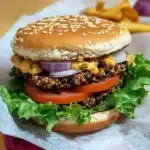
Vegetarian Black Bean Burgers recipe
Ingredients
-
- 1 tablespoon Olive Oil or Vegetable Oil
-
- 1 small Yellow Onion, finely chopped (about 3/4 cup)
-
- 1/2 medium Red Bell Pepper, finely chopped (about 1/2 cup)
-
- 3 cloves Garlic, minced (about 1 tablespoon)
-
- 1 can (15 oz / 425g) Black Beans, rinsed very well and thoroughly drained/patted dry
-
- 1/2 cup Panko Breadcrumbs (or regular breadcrumbs, gluten-free if needed)
-
- 1/2 cup cooked Brown Rice or Quinoa (optional, adds texture and structure)
-
- 1/4 cup chopped Fresh Cilantro or Parsley
-
- 1 large Egg, lightly beaten (or 1 Flax Egg: 1 tbsp flaxseed meal + 3 tbsp water, let sit 5 mins)
-
- 1 teaspoon Ground Cumin
-
- 1 teaspoon Chili Powder
-
- 1/2 teaspoon Smoked Paprika
-
- 1/2 teaspoon Dried Oregano
-
- 1/2 teaspoon Salt (or to taste)
-
- 1/4 teaspoon Black Pepper (or to taste)
-
- Optional: 1-2 tablespoons Worcestershire Sauce (ensure vegetarian/vegan version if needed) or Soy Sauce/Tamari for umami
-
- Optional: Pinch of Cayenne Pepper for heat
-
- Oil for cooking (about 1-2 tablespoons)
Instructions
Step 1: Sauté Aromatics and Vegetables
Heat the 1 tablespoon of olive oil in the large skillet over medium heat. Add the finely chopped onion and red bell pepper. Cook, stirring occasionally, for about 5-7 minutes, until softened and the onion is translucent. Add the minced garlic and cook for another minute, stirring constantly, until fragrant. Remove the skillet from the heat and let the vegetable mixture cool slightly. Purpose: Cooking the vegetables first softens them, deepens their flavour, and crucially, cooks off excess moisture which can make burgers mushy.
Step 2: Prepare the Black Bean Base
Place the thoroughly rinsed and dried black beans in the large mixing bowl. Using a potato masher or a fork, mash about half to two-thirds of the beans. You want a mixture that’s partly paste-like (for binding) but still has some whole or partially mashed beans remaining (for texture). Don’t over-mash into a complete puree. Purpose: Partial mashing releases starches for binding while retaining textural integrity.
Step 3: Combine Burger Mixture
Add the cooled sautéed vegetable mixture to the bowl with the mashed black beans. Add the Panko breadcrumbs, optional cooked brown rice/quinoa, chopped cilantro/parsley, lightly beaten egg (or prepared flax egg), cumin, chili powder, smoked paprika, oregano, salt, and pepper. Add the optional Worcestershire/soy sauce and cayenne pepper, if using.
Step 4: Mix Gently but Thoroughly
Using your hands (clean, of course!) or a sturdy spoon, gently mix all the ingredients together until just combined. Be careful not to overmix, which can make the burgers tough or too pasty. The mixture should hold together when you squeeze a small amount in your hand. If it feels too wet to form patties, add a tablespoon or two more breadcrumbs. If it feels excessively dry and crumbly, add a tiny splash of water or broth (start with 1 tsp).
Step 5: Form the Patties
Divide the mixture into 6 equal portions. Gently form each portion into a patty, about 3/4-inch thick. Try to make them uniform in size and thickness for even cooking. Place the formed patties on a plate or a baking sheet lined with parchment paper. Tip: Slightly indenting the center of each patty with your thumb can help prevent them from puffing up too much during cooking.
Step 6: Chill the Patties (Highly Recommended)
Cover the patties loosely with plastic wrap and refrigerate for at least 30 minutes, or up to several hours. Purpose: Chilling helps the patties firm up significantly, making them less likely to fall apart during cooking. This is a crucial step for structure.
Step 7: Cook the Burgers
You have a few options for cooking:
* Pan-Frying (Recommended for best crust): Heat 1-2 tablespoons of oil in the large skillet over medium heat. Once the oil is shimmering, carefully place the chilled patties in the skillet (cook in batches if necessary, don’t overcrowd). Cook for 5-7 minutes per side, or until deeply golden brown, heated through, and nicely crusted. Adjust heat as needed to prevent burning.
* Baking: Preheat oven to 400°F (200°C). Place the chilled patties on a lightly greased or parchment-lined baking sheet. You can lightly brush or spray the tops with oil for better browning. Bake for 10 minutes, carefully flip the patties, and bake for another 8-12 minutes, or until heated through and slightly firm to the touch. Baking yields a slightly drier texture than pan-frying but is easier for cooking large batches.
* Grilling: See FAQ section for specific grilling tips, as veggie burgers require more care on the grill.
Step 8: Serve
Once cooked, remove the burgers from the skillet or oven. Serve immediately on buns with your favourite toppings.
Nutrition
- Serving Size: one normal portion
- Calories: 250-350 kcal

